the Australian economy in 2019 – house prices, growth and interest rates
December 13th 2018
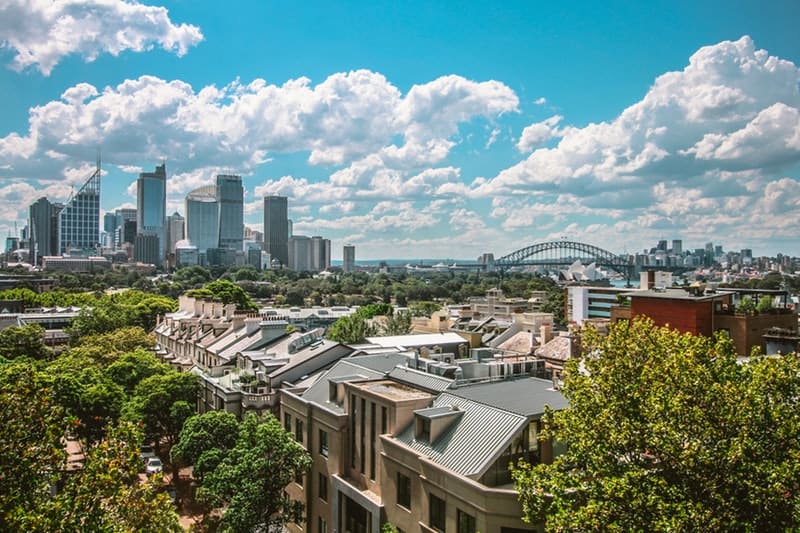
Key Points
- Australian growth has slowed again. The housing cycle downturn and its impact on the economy will likely see growth constrained to around 2.5-3%.
- As a result, spare capacity is likely to remain significant, keeping wages growth and inflation low.
- The RBA is likely to cut rates in 2019 and the housing downturn will likely see Australian shares continue to underperform global shares.
Introduction
2019 is likely to be an interesting year for the Australian economy. Some of the big drags of recent years are receding but housing is turning down, uncertainty is high around the global outlook and it’s an election year, which will add to the uncertainty. This note looks at the main issues around the housing downturn and what it means for the economy and investors.
If you would like to work through your financial plan, goals and investments in 2019, please get in touch.
[ninja_form id=41]
Australian growth has slowed again
September quarter GDP growth was just 0.3% quarter on quarter or 2.8% year on year and was well below expectations.
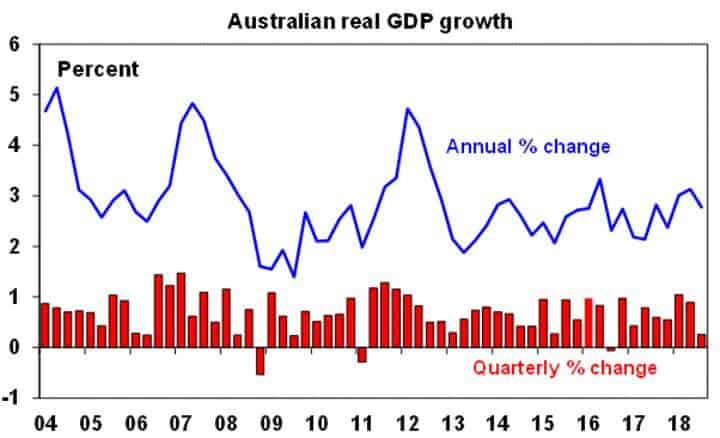
It was concerning for two reasons. Firstly, it suggests that the pickup in growth seen in the first half of the year was an aberration. And secondly it highlighted that the fears around consumer spending as housing slows may be starting to be realised as consumer spending was the big downside surprise.
Housing downturn…
For years we have felt that the combination of surging household debt and surging house prices was Australia’s Achilles heel in that it posed the greatest domestic threat to Australian growth should it all unravel. But we also felt that in the absence of a trigger it was hard to see it causing a major problem. However, over the last year, a combination of factors have come together to turn the housing cycle down and create a perfect storm for house prices in Sydney and Melbourne.
These include: poor affordability; tight credit conditions; a surge in the supply of units; a collapse in foreign demand; borrowers switching from interest only to principle and interest loans; fears by investors now that changes to negative gearing and capital gains tax if there is a change of government (assuming Labor can get it through the Senate) will reduce future demand for their property investment; all of this is seeing the positive feedback loop of recent years (of rising prices > rising demand > rising prices etc) give way to a negative feedback loop (of falling prices > falling demand > falling prices etc). This could all be made worse if immigration levels are cut sharply.
Auction clearance rates have fallen to record lows (in terms of my records!) – which for Sydney and Melbourne are consistent with further price falls running around 8-10% pa – and housing credit continues to slow.
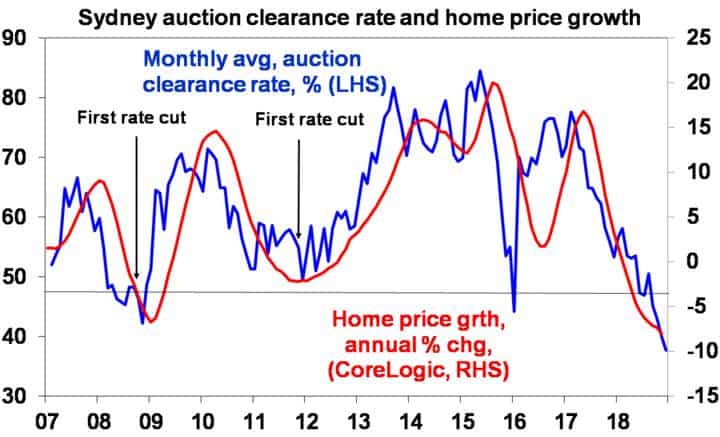
House prices in Sydney and Melbourne will likely have a top to bottom fall of around 20% (10% in 2019) and national average prices will likely have a top to bottom fall of around 10%.
…leading to a drag on growth
While not on the scale of the property crashes seen during the Global Financial Crisis (GFC) in the US and parts of Europe, the Australian property downturn will have a significant negative economic impact. The main impacts are expected to be:
- a direct detraction from growth as the housing construction cycle turns down. This is likely to amount to around 0.4 percentage points per annum (which was what it added on average during the construction boom).
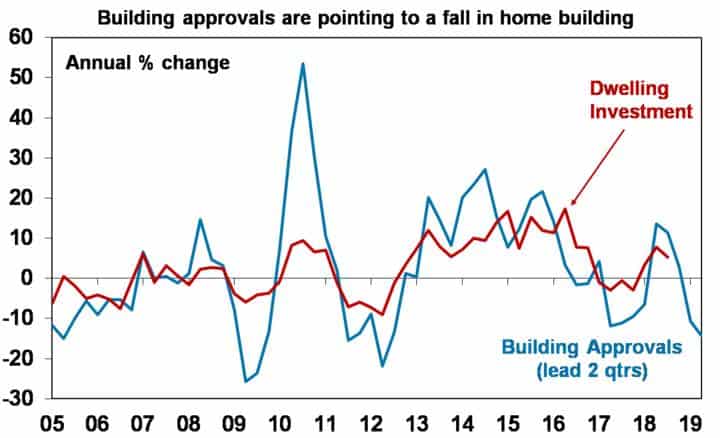
- reduced demand for household equipment retail sales as dwelling completions top out and decline.
- a negative wealth effect on consumer spending of around 1% pa. Rising housing wealth helped drive decent growth in consumer spending in NSW and Victoria as households reduced the amount they saved as their housing wealth rose. This is now likely to go in reverse detracting around 0.6 percentage points from GDP growth.
- there could also be a feedback loop into further bank credit tightening if non-performing loans and defaults rise.
Taken together these could detract 1-1.2 percentage points from growth over the next year.
No recession, but constrained growth
Clearly a deeper slump in national property prices – say a 25% top to bottom fall rather than the 10% we are expecting – would cause severe economic damage but in the absence of much higher interest rates or unemployment causing mass defaults this is unlikely. Australia hasn’t seen the sort of deterioration in lending standards seen in the US prior to the GFC that saw people with “no income, no job, no assets (NINJA’s)” get loans and where the Fed raised rates 17 times over two years! And unlike in the US, Australian mortgages are full recourse loans so there is no “jingle mail”. So, a US GFC style surge in defaults adding to downwards pressure on prices is unlikely.
Barring a deeper property slump, a recession is unlikely:
- The drag on growth from slumping mining investment (which was averaging around 1.5 percentage points per annum) is fading as mining investment is getting close to the bottom.
- Surveys point to a recovery in non-mining investment. Business investment plans for this financial year are pointing to a 4% gain and 7% for non-mining investment.
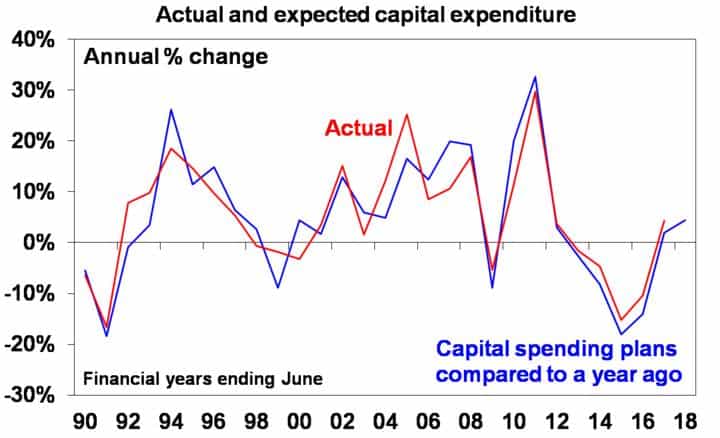
- Public infrastructure spending is rising and has further to go.
- Net exports are likely to continue adding to growth, although the US/China trade war is a threat here.
- And there are even a couple of positives for consumer spending in the form of lower petrol prices (saving around $10 a week for a typical household) and likely pre-election tax cuts or handouts although these may not kick in until July 2019. Under a Labor Government this looks likely to be more skewed to low and middle income earners with high income earners facing tax hikes.
Given the cross currents, our assessment is that growth is likely to be around 2.5-3% going forward. This is not the recession some fear but it’s well down from the 3.5% pace the RBA expects.
Inflation to stay lower for longer
Growth around 2.5-3% won’t be enough to further eat into spare labour market capacity so the decline in unemployment is likely to stall (job vacancies appear to be slowing) and underemployment is likely to remain high at 8.3%. This in turn points to wages growth remaining weak. Meanwhile, it’s hard to see much uptick in other sources of inflationary pressure: competition and pressure for price discounting remains intense and commodity prices have fallen this year with the oil price falling over 30% from its recent high feeding through to lower petrol prices and the link between moves in the $A and inflation has been weak for years now. The latest Melbourne Institute Inflation Gauge points to a further fall in inflation into this quarter with its trimmed mean measure of underlying inflation up just 1.3% year on year in November.
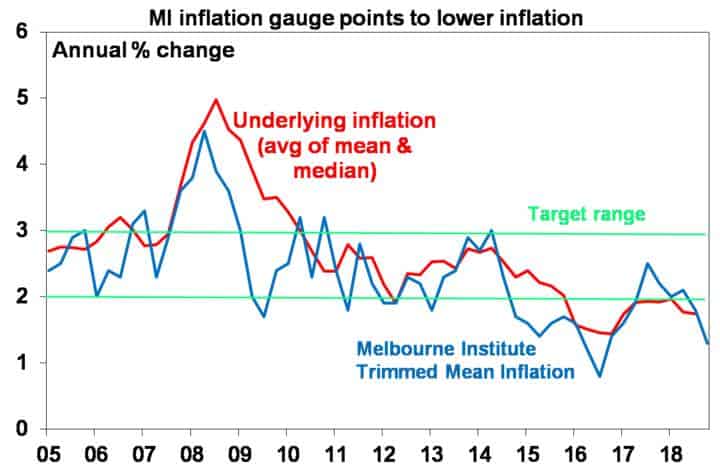
RBA to cut in 2019
Against the backdrop of falling house prices, tight credit conditions and constrained growth, which will keep wages growth weak and inflation below target for longer we see the next move by the RBA being a rate cut. However, it will take a while to change the RBA’s thinking, so we don’t see rates being cut until second half next year but won’t rule out an earlier move if things are weaker earlier than we are expecting. By end 2019 the cash rate is likely to have fallen to 1%.
Rate cuts won’t be aimed at re-inflating the property market but supporting households with a mortgage to offset the negative wealth impact on spending. A 0.25% rate cut roughly saves a household with a $400,000 mortgage $1000 a year in interest costs. And banks will likely have no choice to pass the cuts on given the bad publicity not passing them on will generate.
Implications for investors
There are several implications for Australian investors.
First, bank deposits rates will remain poor.
Second, with the RBA likely to cut rates and the Fed hiking (albeit slowing) the $A is likely to fall into the high $US0.60s.
Third, Australian bonds are likely to outperform global bonds.
Finally, while Australian shares are still great for income, global shares are likely to remain out-performers for capital growth. The housing downturn will weigh on retailers, retail property, banks and building material stocks.
[ninja_form id=41]
Important note: While every care has been taken in the preparation of this article, AMP Capital Investors Limited (ABN 59 001 777 591, AFSL 232497) and AMP Capital Funds Management Limited (ABN 15 159 557 721, AFSL 426455) makes no representations or warranties as to the accuracy or completeness of any statement in it including, without limitation, any forecasts. Past performance is not a reliable indicator of future performance. This article has been prepared for the purpose of providing general information, without taking account of any particular investor’s objectives, financial situation or needs. An investor should, before making any investment decisions, consider the appropriateness of the information in this article, and seek professional advice, having regard to the investor’s objectives, financial situation and needs. This article is solely for the use of the party to whom it is provided.
